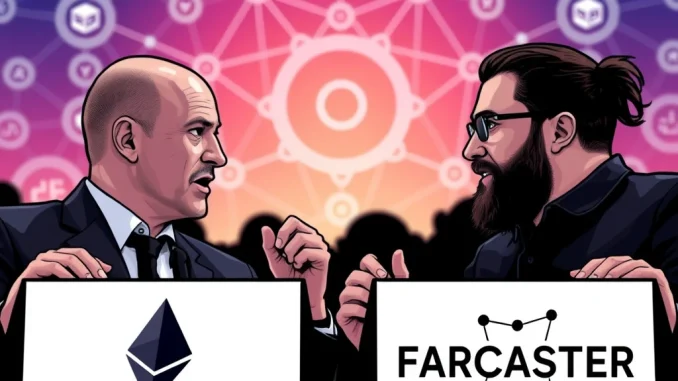
A public disagreement between two influential figures in the crypto space recently grabbed attention, highlighting ongoing tensions within the Ethereum ecosystem. The debate centered on a critical issue: how to achieve effective Ethereum scaling while balancing decentralization and usability. This isn’t just a technical squabble; it touches on the core philosophy of Web3.
Why Vitalik Buterin Championed Local Nodes
The discussion kicked off when Vitalik Buterin, Ethereum’s co-founder, took to WarpCast, the social platform built on Farcaster technology. Buterin expressed his view on making Ethereum Layer 1 (L1) scaling more practical, particularly for individuals running local nodes for personal use. His point seemed to be that while L2 solutions are crucial, the base layer should still be accessible and functional for those who want to interact directly without relying solely on third parties.
Running a local node means an individual has a full copy of the Ethereum blockchain and can verify transactions and interact with the network directly, enhancing personal sovereignty and network decentralization.
Dan Romero’s Critique: Outdated Priorities?
However, this perspective didn’t sit well with Dan Romero, co-founder of the Web3 social platform Farcaster. Romero quickly voiced his criticism, arguing that Buterin’s focus on optimizing L1 for individual local nodes was perhaps an outdated priority. Romero contended that this approach might actually hinder the broader ecosystem’s progress by diverting attention or resources from solutions that benefit a wider user base, such as Layer 2 scaling.
Romero’s frustration also extended to what he sees as Ethereum’s current reliance on a mix of:
- Individual local nodes (which can be resource-intensive to run).
- Centralized service providers, specifically mentioning centralized sequencers like Coinbase, which process transactions off-chain before batching them for L1 settlement.
He suggested this combination creates a complex and potentially bottlenecked environment rather than a streamlined, scalable one ready for mass adoption.
The Blunt Response: “Consider Selling Your ETH”
The exchange escalated when Buterin responded directly to Romero’s critique. In a notably blunt reply, Buterin told Romero to “consider selling your ETH.” This sharp retort underscored the depth of disagreement and perhaps Buterin’s impatience with criticism that he perceives as missing the nuance of maintaining decentralization ideals.
This interaction highlights a fundamental tension within the Ethereum community and the broader Web3 space:
Decentralization Ideals vs. Practical Scalability & Usability
| Vitalik Buterin’s Stance (Apparent) | Dan Romero’s Stance (Apparent) |
| Prioritizes making L1 accessible for individual sovereignty via local nodes. | Prioritizes broader ecosystem scalability and usability, questioning the focus on individual L1 nodes. |
| Sees value in individuals verifying the chain directly. | Concerned about reliance on both individual nodes and centralized sequencers. |
| Suggests critics might not align with core ETH values if they dismiss L1 node accessibility. | Believes focus should shift to solutions that benefit the many, not just individual node runners. |
What Does This Clash Mean for Ethereum’s Future?
This public debate, while perhaps uncomfortable, brings critical questions to the forefront:
- How important is it for individuals to be able to run a full validating L1 node easily?
- At what point does optimizing for individual node runners potentially conflict with achieving mass scalability via L2s and other methods?
- How should the ecosystem navigate the current reliance on centralized entities (like sequencers) within scaling solutions?
The exchange between Buterin and Romero underscores that achieving the vision of a decentralized, scalable Web3 platform is an ongoing challenge with differing perspectives on the best path forward. The tension between maintaining the core ethos of decentralization (empowered by things like local nodes) and the pragmatic need for performance and usability (often facilitated by more centralized components or complex L2 tech) remains a central theme in Ethereum’s development journey.
Summary: A Debate That Matters
The candid exchange between Vitalik Buterin and Dan Romero on Farcaster reveals the passionate, sometimes conflicting, views on how Ethereum scaling should evolve. While Buterin advocates for keeping the L1 accessible for individual local nodes, Romero argues for a focus that better serves the broader ecosystem, pointing out concerns about centralization. This isn’t just theoretical; it impacts the future direction of one of the most important blockchain networks and the platforms built upon it, like Farcaster itself. The debate continues as Ethereum strives to balance its foundational principles with the demands of widespread adoption.



